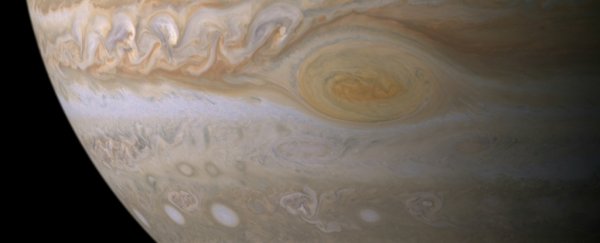Jupiter's Great Red Spot is the largest storm in the Solar System. Located in Jupiter's lower atmosphere, this storm is so big that you could fit two or three Earths inside of it. And this 'perpetual hurricane' has been raging for centuries.
Now, a team of scientists at Boston University believe that it might just offer an explanation for one of the biggest mysteries about Jupiter.
The temperature of Jupiter's upper atmosphere is a curious thing. Based on Jupiter's distance from the Sun and what we know about how the Sun heats planets, it should only be about 80 degrees Fahrenheit (27 degrees Celsius).
But regions of Jupiter's atmosphere can range from 800 to 1340 degrees Fahrenheit (427 to 727 degrees Celsius). And though scientists know that Jupiter's giant auroras could boost the temperature a little, these glowing swirls of electrically charged particles aren't enough to explain the heat and how it's distributed across the planet.
And Jupiter isn't the only planet with mysterious heat. Saturn, Uranus, and Neptune all experience unusually high temperatures in their atmospheres.
"We call this the energy crisis nowadays, because it's been unresolved since the 1970s," James O'Donoghue told National Geographic.
The great red hotspot
Using the NASA InfraRed Telescope Facility in Hawaii, the team of scientists located a hot spot conveniently lingering above the Great Red Spot.
They studied light emitted by a form of hydrogen called H3+ in the upper reaches of Jupiter's atmosphere to figure out the temperature of the area around it.
"We could see almost immediately that our maximum temperatures at high altitudes were above the Great Red Spot far below - a weird coincidence or a major clue?" O'Donoghue said in a Boston University press release.
About 500 miles (804 km) above the Great Red Spot, temperatures rise above 2400 degrees Fahrenheit (1315 degrees Celsius), which is hotter than the hottest lava on Earth.
The team believes that acoustic (sound) waves rising from the storm are crashing into Jupiter's upper atmosphere, shaking its atoms and heating it up in the process.
"A good analogy for this is it's pretty much like stirring a cup of coffee with a spoon," O'Donoghue told the Verge. "If you're stirring it clockwise, but then you suddenly stir it anti-clockwise, there will be a lot of sloshing around… And that sloshing around, you can actually hear that. It indicates there are actually some sound waves coming from that sloshing."
Because it's unlikely that the Great Red Spot is warming the entire planet, this wouldn't entirely solve the mystery of Jupiter's heat. And Amy Simon of NASA's Goddard Spaceflight Centre told NPR that although these observations are intriguing, they should be viewed with caution since methane can produce similar signals to that of the H3+ molecules.
Back on Earth
But if these scientists are right, what we learn can teach us a lot about other planets - including our own.
According to the National Geographic, similar processes happen on Earth. The atmosphere above hurricanes and tsunamis here can be slightly warmer. Air moving over large mountain ranges like the Andes mountains might crash into rocks, sending acoustic waves into the upper atmosphere and heating it up.
"Jupiter is like a giant laboratory for extreme physics," O'Donoghue said. "It's teaching us how storms interact with the upper atmosphere in a way that is difficult to measure on Earth."
And with NASA's Juno spacecraft venturing closer to Jupiter than any spacecraft before it, scientists expect to get an even better look at the Great Red Spot, possibly getting a better idea of what caused the storm in the first place.
The results were published in the journal Nature.
This article was originally published by Business Insider.
More from Business Insider:
